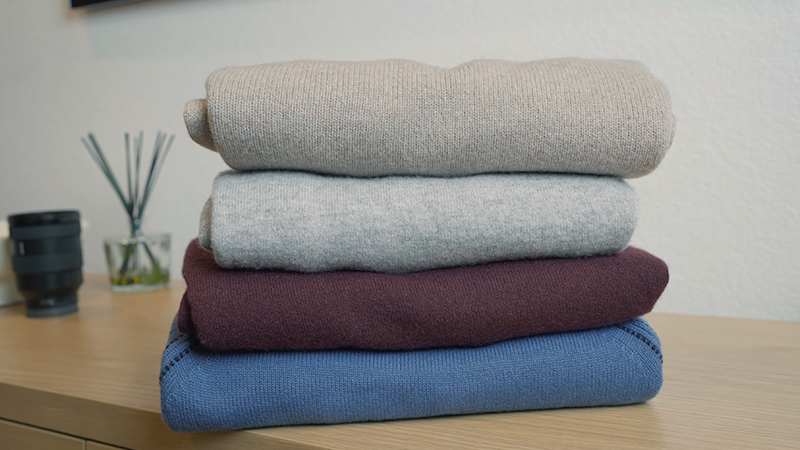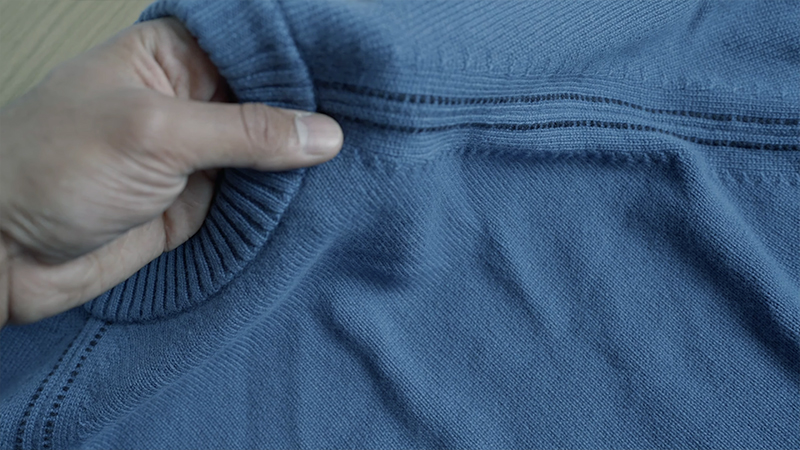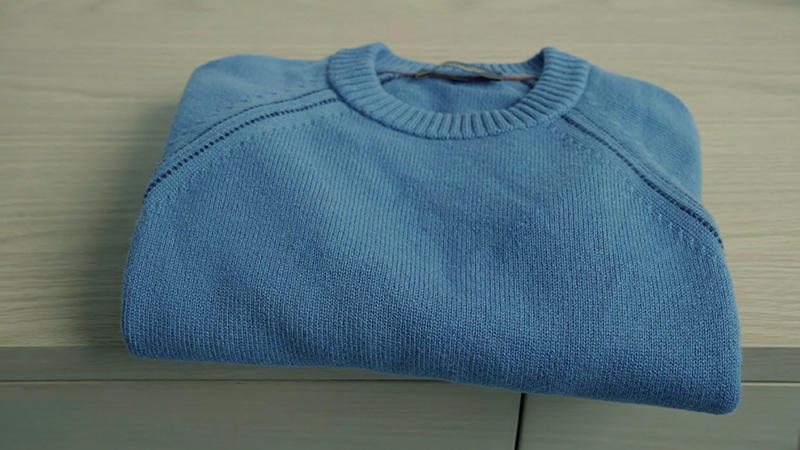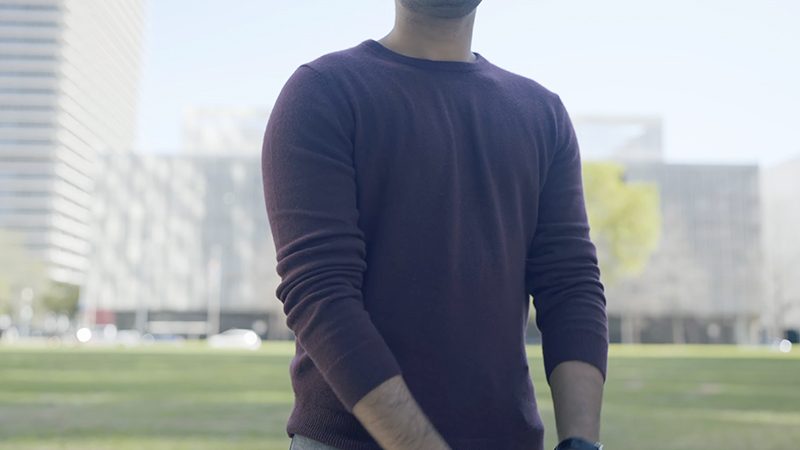Cashmere, the epitome of luxury in the world of textiles, is celebrated for its unparalleled softness, exquisite warmth, and timeless elegance. Yet, beneath its sumptuous allure lies a delicate nature susceptible to the effects of wear and time.
The question that often arises is whether cashmere, as remarkable as it is, succumbs to the inevitable stretching that accompanies prolonged use.
In this exploration, we delve into the intricate characteristics of cashmere fibers and the various factors at play, unraveling the truth about whether this coveted fabric indeed stretches with wear.
Delving into the science, care, and practical considerations, we aim to demystify the behavior of cashmere in the hands of its wearers.

Does Cashmere Stretch With Wear?
Yes, cashmere does stretch with wear. Cashmere, a luxurious and highly sought-after natural fiber, is known for its softness, warmth, and comfort.
While it has many desirable qualities, it is not immune to the effects of wear and stretching over time.
Cashmere garments, such as sweaters, scarves, and cardigans, can indeed stretch with prolonged use, but several factors contribute to this phenomenon.
Natural Fiber Characteristics
Cashmere is sourced from the fine undercoat of cashmere goats. Due to its delicate and fine texture, it is susceptible to stretching when exposed to tension or pressure, which is common during wear.
The natural elasticity of cashmere helps it return to its original shape to some extent, but repeated stretching can lead to permanent deformation.
Wearing Patterns
How you wear and use your cashmere garments can influence how much they stretch.
For instance, if you frequently wear a cashmere sweater without resting it between uses, the fabric is more likely to stretch out over time. Additionally, if you pull or tug on cashmere too forcefully, it can lead to noticeable stretching.
Weight and Length
The weight of the cashmere garment and its length can affect how much it stretches.
Longer and heavier cashmere items, such as long cardigans or dresses, are more prone to stretching due to the added weight they must support.
Cleaning and Care
The care and cleaning methods you use for your cashmere garments can also impact their elasticity.
Harsh washing conditions, such as using hot water, excessive agitation, or improper drying techniques, can contribute to stretching. Always follow the care instructions provided by the manufacturer to maintain the garment’s shape.
Elasticity Recovery
Cashmere has a natural ability to recover some of its original shape due to its inherent elasticity.
However, this recovery may not be complete, especially if the stretching is severe or repeated. Gently reshaping the garment and laying it flat to dry can help it regain some of its original form.
How Cashmere Behaves During Wear

Cashmere behaves in distinct ways during wear due to its unique characteristics and composition.
Here’s a closer look at how cashmere behaves:
Softness and Comfort
Cashmere is renowned for its exceptional softness. When worn, it feels gentle against the skin, providing a luxurious and comfortable experience.
This makes cashmere a popular choice for garments that come into direct contact with the body, such as sweaters, scarves, and hats.
Insulation and Warmth
Cashmere is an excellent insulator, trapping heat close to the body. When worn, it provides natural warmth, making it suitable for colder climates and seasons.
Despite its warmth, cashmere is also breathable, allowing moisture to escape, which helps regulate body temperature.
Lightweight Nature
Despite its warmth, cashmere is surprisingly lightweight. This characteristic makes it versatile, allowing for the creation of garments that offer substantial insulation without excessive bulk. It’s an excellent choice for layering in various weather conditions.
Natural Stretch
Cashmere possesses a natural elasticity due to the fine, crimped fibers that make up the material. This allows cashmere garments to gently conform to the body’s shape.
While this elasticity provides comfort, it also means that cashmere can stretch with prolonged wear, especially in areas that experience tension or friction.
Pilling
Pilling is a common occurrence with cashmere. The fine fibers can rub together during wear, leading to the formation of small balls of fuzz on the surface of the fabric.
This is a normal characteristic of cashmere and can be managed through proper care and maintenance.
Drape and Flow
Cashmere has an elegant drape, allowing it to flow gracefully over the body. This quality is particularly noticeable in garments like shawls, wraps, and dresses. It lends an air of sophistication to the wearer.
Durability and Longevity
While cashmere is a delicate and luxurious material, it is also surprisingly durable when cared for properly. With the right maintenance, cashmere garments can last for many years, providing enduring comfort and style.
Sensitivity to Moisture and Heat
Cashmere is sensitive to moisture and heat. Excessive exposure to water or high temperatures, especially during washing and drying, can lead to stretching, shrinkage, or damage to the fibers. It’s crucial to follow the care instructions provided by the manufacturer.
Preventing Overstretching
Preventing overstretching is essential for maintaining the shape and longevity of your cashmere garments.
Here are some effective tips to help you preserve the integrity of your cashmere items:
Rotate Your Garments
In addition to preventing overstretching, rotating your cashmere garments offers several benefits. It allows them to air out and breathe, reducing the risk of odors and prolonging the time between washes.
Moreover, it helps distribute wear and tear evenly across your wardrobe, ensuring that no single piece is subjected to excessive stress.
Avoid Excessive Pulling or Tugging
When handling cashmere, treat it with care. Gently ease it onto your body without applying undue force. Pay special attention to the sleeves, neckline, and other areas where stretching is more likely to occur.
If you encounter resistance, take a moment to adjust the garment rather than pulling or tugging. This small act of mindfulness can go a long way in preserving the shape of your cashmere.
Avoid Hanging
Hanging cashmere for extended periods can lead to distortion and stretching, especially in heavier garments. Instead, opt for folding.
If you must hang a cashmere item temporarily, use padded hangers to distribute the weight more evenly. But always return it to a folded position for long-term storage.
Fold Carefully
When folding cashmere, do so gently to prevent sharp creases. While cashmere is remarkably resilient, harsh creases can weaken the fibers over time, potentially leading to stretching.
Lay the garment flat, smoothing out any wrinkles by hand, before folding it along its natural lines. This ensures a more even distribution of pressure across the fabric.
Use a Soft Brush or Comb
When addressing pilling, it’s important to do so with a gentle touch. A soft-bristled brush or a cashmere comb can be effective tools for removing pills.
Begin with light, short strokes in one direction, then switch to the opposite direction. Take care not to apply too much pressure, as excessive brushing can lead to stretching.
Hand Wash
Hand washing is often the preferred method for cleaning cashmere. If using a machine, select the delicate cycle with cold water and a mild detergent formulated for delicate fabrics.
The gentle agitation and lower water temperature will help minimize the risk of overstretching.
Use Cold Water for Rinsing
After washing, rinse your cashmere in cold water. This helps to close the fibers and maintain the garment’s shape. Avoid hot water, as it can cause the fibers to expand and potentially lead to stretching.
Gently Squeeze Out Excess Water
When removing excess water after washing, be gentle. Avoid wringing or twisting the garment, as this can put undue stress on the fibers.
Instead, carefully squeeze the fabric to remove water and then proceed to lay it flat on a clean towel for drying.
Lay Flat to Dry
Opting for flat drying is crucial for preventing overstretching. Hanging cashmere can lead to unnecessary strain on the fibers.
By laying it flat on a clean towel or drying rack, you allow the garment to regain its natural shape without added stress.
Store Properly
When storing cashmere during off-seasons, choose a cool, dry place away from direct sunlight. Avoid compressing it into tight spaces, as this can lead to deformation.
Proper storage ensures that your cashmere retains its original shape and quality, ready for the next time you wear it.
Avoid Heavy Objects on the Top
Placing heavy objects on top of stored cashmere items can lead to unwanted stretching and distortion. Keep the storage area free from anything that may press down on your cashmere pieces, ensuring they remain in pristine condition.
Care and Maintenance for Minimizing Stretching

Caring for your cashmere garments with diligence and attention to detail is crucial in minimizing stretching.
Here’s an in-depth guide on how to maintain your cashmere items to prevent overstretching:
Use a Delicate Cycle
Washing cashmere by hand is the gentlest method to ensure its longevity. Use a basin or sink with lukewarm water and a mild detergent designed for delicate fabrics.
Gently agitate the water to create suds, then submerge the garment. Gently swish it around, paying extra attention to areas prone to dirt or sweat accumulation. Rinse thoroughly with cool water.
Avoid Excessive Agitation
Whether washing by hand or in a machine, minimize agitation. Gently press and squeeze the garment to clean it, avoiding any harsh rubbing or wringing. This helps to prevent unnecessary strain on the fibers, which can lead to stretching.
Use Cold Water for Rinsing
After washing, rinse your cashmere in cold water. This helps to close the fibers and maintain the garment’s shape. Avoid hot water, as it can cause the fibers to expand, potentially leading to stretching.
Gently Squeeze Out Excess Water
To remove excess water after washing, avoid wringing or twisting the garment, as this can put undue stress on the fibers.
Instead, carefully squeeze the fabric from top to bottom to remove excess moisture. Do not apply excessive force.
Lay Flat to Dry
Opt for flat drying to prevent overstretching. Lay your cashmere garment on a clean, dry towel or on a drying rack.
Smooth out any wrinkles by hand. Gently reshape the garment if needed, particularly in areas like sleeves or hemlines, to maintain its original form.
Avoid Hanging
Hanging cashmere for extended periods can lead to distortion and stretching, especially in heavier garments.
If you must hang a cashmere item temporarily, use padded hangers to distribute the weight more evenly. However, always return it to a folded position for long-term storage.
Fold Carefully
When folding cashmere, do so gently to prevent sharp creases. While cashmere is remarkably resilient, harsh creases can weaken the fibers over time, potentially leading to stretching.
Lay the garment flat, smoothing out any wrinkles by hand, before folding it along its natural lines. This ensures a more even distribution of pressure across the fabric.
Rotate Your Garments
In addition to preventing overstretching, rotating your cashmere garments offers several benefits. It allows them to air out and breathe, reducing the risk of odors and prolonging the time between washes.
Moreover, it helps distribute wear and tear evenly across your wardrobe, ensuring that no single piece is subjected to excessive stress.
Store Properly
When storing cashmere during off-seasons, choose a cool, dry place away from direct sunlight.
Avoid compressing it into tight spaces, as this can lead to deformation. Use breathable garment bags or clean, folded tissue paper to protect it from dust and moths.
Avoid Heavy Objects on Top
Placing heavy objects on top of stored cashmere items can lead to unwanted stretching and distortion. Keep the storage area free from anything that may press down on your cashmere pieces, ensuring they remain in pristine condition.
Practical Tips for Preserving Shape

Preserving the shape of your clothing, including cashmere garments, is essential to extend their lifespan and maintain their original look and fit.
Here are some practical tips to help you preserve the shape of your clothing:
Choose the Right Hangers
When hanging your clothes, opt for hangers that are designed to support the specific type of garment.
For cashmere sweaters and knits, use padded or contoured hangers to help maintain their shape. Avoid wire hangers, which can lead to stretched-out shoulders.
Use Garment Protectors
Garment protectors like shoulder covers and garment bags are essential for preserving the shape of clothing during storage. They shield your garments from dust, light, and potential damage caused by other items in your closet.
Fold Delicate Items
Delicate items like cashmere sweaters should be folded rather than hung. Folding prevents stretching and maintains the garment’s shape. Use tissue paper or cloth between layers to minimize creases.
Avoid Overloading Drawers
Overstuffing drawers can lead to wrinkling and distortion of clothing. Ensure there’s enough space in your drawers for your clothes to lie flat and maintain their shape.
Follow Care Instructions
Always adhere to the care instructions on the garment’s label. Different fabrics and garments may require specific washing, drying, or ironing techniques to preserve their shape.
Use Proper Folding Techniques
When folding clothes, use proper techniques to minimize creases and maintain the shape. For example, fold cashmere sweaters by laying them flat, smoothing out wrinkles, and folding them neatly along their natural lines.
Invest in Quality Hangers and Storage Solutions
Consider investing in high-quality hangers and storage solutions designed to preserve clothing shapes. There are specialized hangers and storage systems available for suits, dresses, and other specific garment types.
FAQs
Does cashmere stretch over time?
Yes, cashmere can stretch with wear, especially in areas that experience tension or friction. Its fine fibers possess natural elasticity, but repeated stretching can lead to deformation.
Can I prevent cashmere from stretching?
While you can’t entirely prevent stretching, you can minimize it by rotating your garments, avoiding excessive pulling or tugging, and following proper care instructions, including hand washing and flat drying.
Is it normal for Cashmere to stretch a little?
Yes, it’s normal for cashmere to experience slight stretching with wear. The natural elasticity of the fiber allows it to return to its original shape to some extent, but it’s important to handle it gently.
How can I fix stretched cashmere?
Gently reshape the stretched area and lay the garment flat to dry. Avoid hanging, as this can exacerbate stretching. Additionally, consider professional alterations for significant stretching.
Can I wear my cashmere garment without it stretching?
While some stretching is inevitable with wear, taking precautions like avoiding excessive force during wear, rotating your garments, and following proper care instructions can help maintain its shape and minimize stretching.
Wrap Up
Cashmere’s delicate nature, while lending it unmatched softness and warmth, also renders it susceptible to stretching with wear.
The fine, crimped fibers that define cashmere’s luxurious texture possess a natural elasticity that allows the fabric to gently conform to the body. However, repeated tension and improper care can lead to noticeable deformation over time.
By employing thoughtful handling, following recommended care practices, and rotating garments, one can mitigate the risk of overstretching.
With these considerations in mind, one can enjoy the enduring elegance of cashmere, ensuring it maintains its original shape and exquisite quality for seasons to come.
Embracing its delicate nature, we preserve the timeless allure of this cherished textile.
Leave a Reply